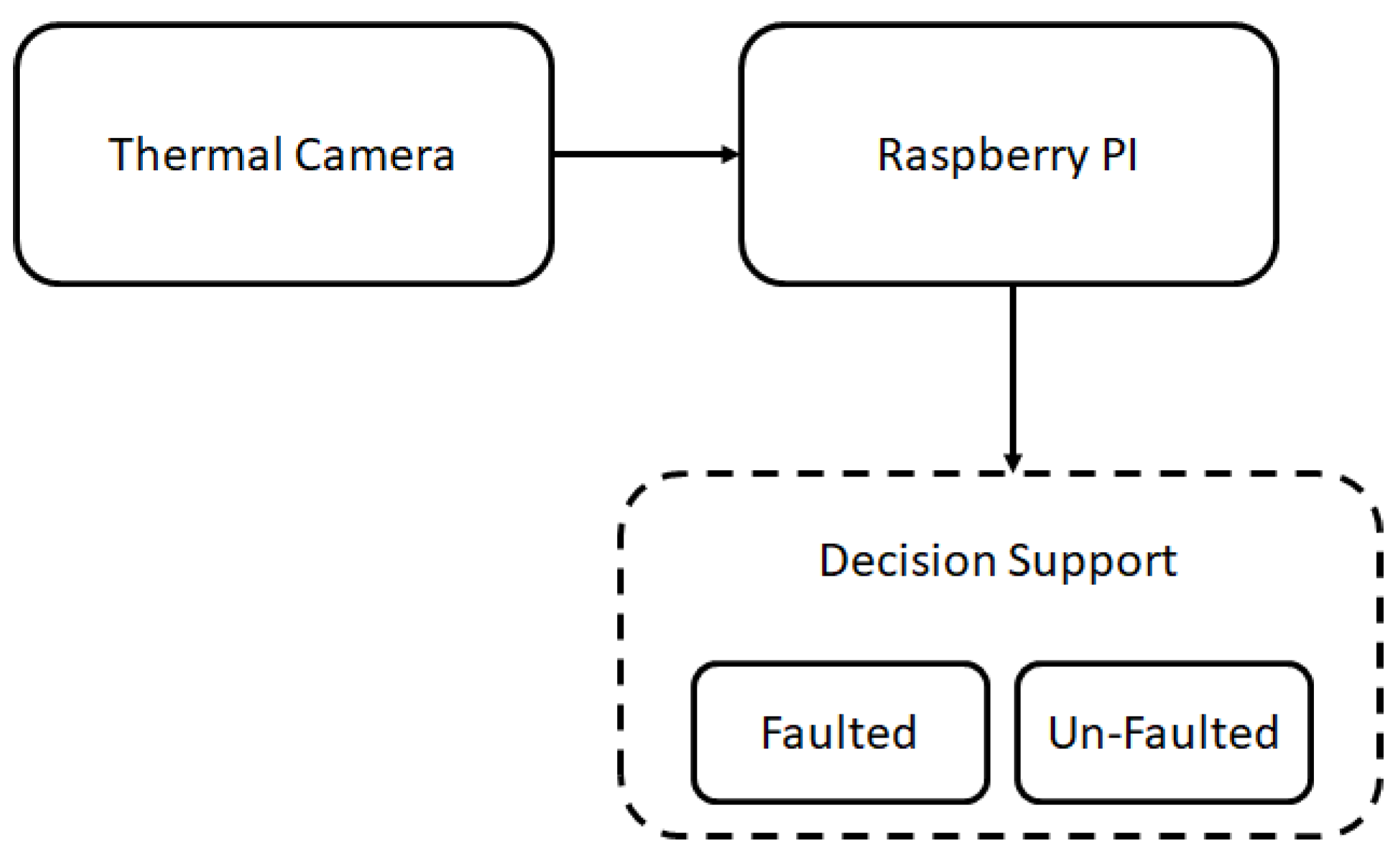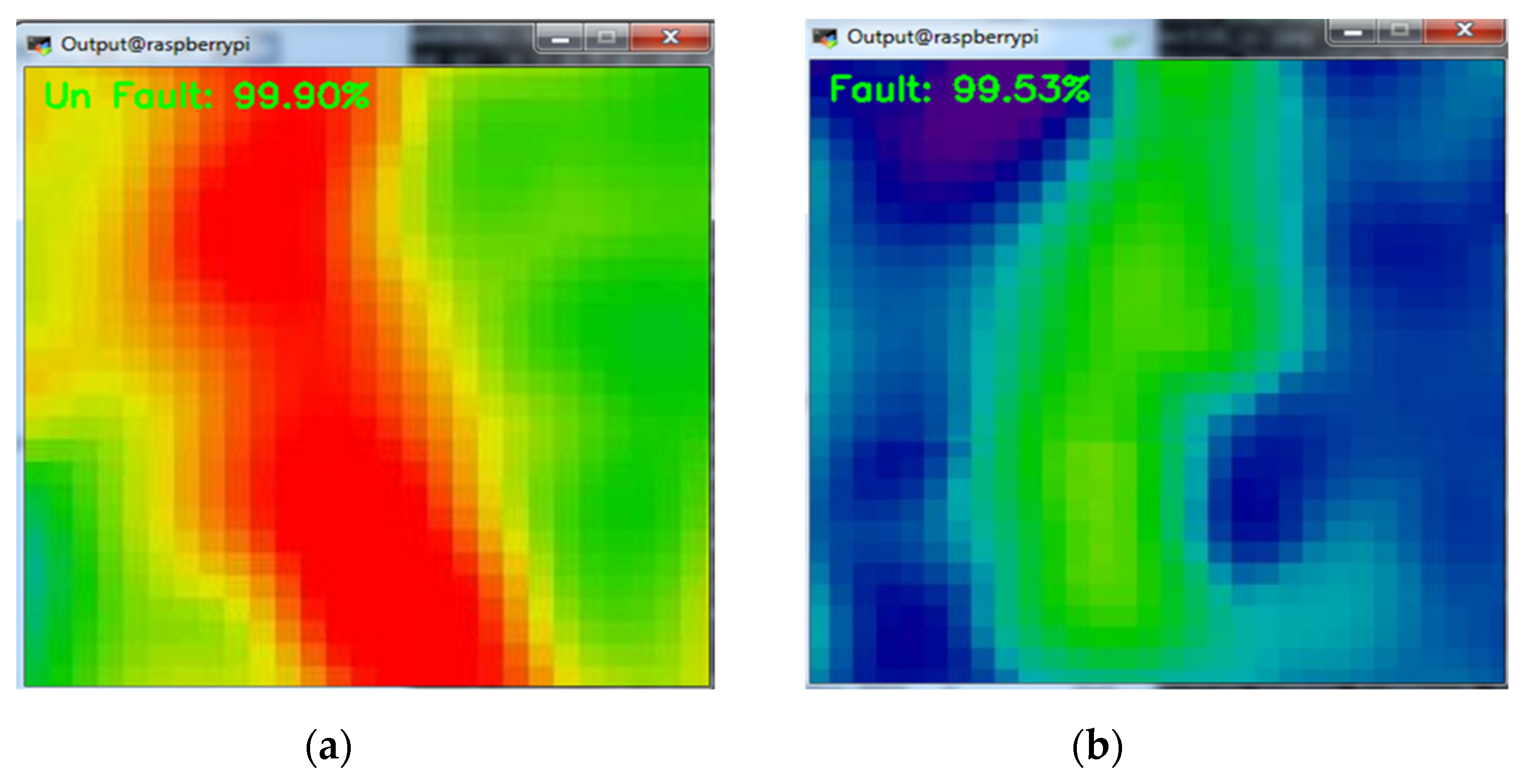Identification of Electrical Faults in Underground Cables Using Machine Learning Algorithm †
Abstract
:1. Introduction
2. Materials and Methods
2.1. Thermal Image Acquisition System
2.2. Convolutional Neural Network
- INPUT [32 × 32 × 3] holds the raw pixel values of the image, whereas the image has a width of 32, height of 32, and three color channels, R, G, B.
- CONV layer computes the output of the neurons that are connected to local regions in the input, each computing a dot product between their weights and a small region they are connected to in the input volume. This may result in a volume such as [32 × 32 × 42] if the filter size is set to 42.
- RELU layer applies an elementwise activation function, such as the max(0, x) thresholding at zero. This leaves the size of the volume unchanged ([32 × 32 × 42]).
- POOL layer performs a down-sampling operation along the spatial dimensions (width, height), resulting in volume such as [16 × 16 × 42].
- FC or Fully-Connected layer computes the class scores, resulting in the volume of size [1 × 1 × 2], where each of the two numbers correspond to a class score, such as among the two categories (Faulted or Un-faulted).
2.3. Performance Metrics
3. Results and Discussion
4. Conclusions
Author Contributions
Conflicts of Interest
References
- Orosco, E.V. Simulation results of an efficient and innovative sun engine for solar to electrical energy conversion. In Collection of Technical Papers, Proceedings of the 35th Intersociety Energy Conversion Engineering Conference and Exhibit (IECEC) (Cat. No. 00CH37022), Las Vegas, NV, USA, 24–28 July 2000; American Institute of Aeronautics and Astronautics: Reston, VA, USA, 2000; Volume 2, pp. 908–914. [Google Scholar]
- Gurkaynak, Y.; Li, Z.; Khaligh, A. A novel grid-tied, solar powered residential home with plug-in hybrid electric vehicle (PHEV) loads. In Proceedings of the 2009 IEEE Vehicle Power and Propulsion Conference, Dearborn, MI, USA, 7–10 September 2009; pp. 813–816. [Google Scholar]
- Lyons, J.P.; Michael, C.R.; Paul, V.; Robert, W.T. Wind Turbine Technology—The Path to 20% US Electrical Energy. In Proceedings of the 2008 IEEE Power and Energy Society General Meeting-Conversion and Delivery of Electrical Energy in the 21st Century, Pittsburgh, PA, USA, 20–24 July 2008; pp. 1–4. [Google Scholar]
- Kumar, A.; Karandikar, P.B.; Datta, S. Chavan. Generating and saving energy by installing wind turbines along the railway tracks. In Proceedings of the 2015 International Conference on Energy Systems and Applications, Pune, India, 30 October–1 November 2015; pp. 25–27. [Google Scholar]
- ElKhodary, S.M.; Mahmoud, H.M.; Qotb, S.A.; and Sharouda, E.E.D.F. The role of nuclear energy in the future of energy systems in Egypt. In Proceedings of the 2017 Nineteenth International Middle East Power Systems Conference (MEPCON), Cairo, Egypt, 19 December 2017; pp. 638–643. [Google Scholar]
- Oral, B.; Ferdun, D. The Impacts of natural disasters on power systems: anatomy of the Marmara earthquake blackout. Bülent, and Ferdun Dönmez. Acta Polytechnica Hungarica 2010, 7, 107–118. [Google Scholar]
- Musa, M.H.H.; He, Z.; Fu, L.; Yujia, D. A covariance indices based method for fault detection and classification in a power transmission system during power swing. Int. J. Electr. Power Energy Syst. 2019, 105, 581–591. [Google Scholar] [CrossRef]
- Niaki, S.H.; Ashrafi, H.; Karegar, K.; Ghalei, M.M. A novel fault detection method for VSC-HVDC transmission system of offshore wind farm. Int. J. Electr. Power Energy Syst. 2015, 73, 475–483. [Google Scholar] [CrossRef]
- Samantaray, S.R. Decision tree-based fault zone identification and fault classification inflexible AC transmissions-based transmission line. IET Gener. Transm. Distrib. 2009, 3, 425–436. [Google Scholar] [CrossRef]
- Gupta, M.; Deekshith, S.; Patchava, V.; Menezes, V. Healthcare based on iot using raspberry pi. In Proceedings of the 2015 International Conference on Green Computing and Internet of Things (ICGCIoT), Greater Noida, India, 8–10 October 2015; pp. 796–799. [Google Scholar]
- Sharma, J.M.; Anbarasu, C.C.; Shanmugasundaram, M. Iris movement based wheel chair control using raspberry Pi—A state of art. In Proceedings of the 2017 Innovations in Power and Advanced Computing Technologies (i-PACT), Vellore, India, 21–22 April 2017; pp. 1–5. [Google Scholar]
- Szabó, R.; Gontean, A.; Sfiraţ, A. Robotic arm control in space with color recognition using a Raspberry PI. In Proceedings of the 2016 39th International Conference on Telecommunications and Signal Processing (TSP), Vienna, Austria, 27–29 June 2016; pp. 689–692. [Google Scholar]
- Adsul, A.C.; Bhosale, V.K.; Autee, R.M. Automated blood bank system using Raspberry PI. In Proceedings of the 2018 2nd International Conference on Inventive Systems and Control (ICISC), Coimbatore, India, 19–20 January 2018; pp. 252–255. [Google Scholar]
- Kumar, K.; Kishore, S.; Durai, M.; Vadivel, T.; Kumar, K.A. Smart traffic system using raspberry pi by applying dynamic color changer algorithm. In Proceedings of the 2017 IEEE International Conference on Smart Technologies and Management for Computing, Communication, Controls, Energy and Materials (ICSTM), Chennai, India, 2–4 August 2017; pp. 146–150. [Google Scholar]
- Guzman, A.M.; Goryawala, M.; Wang, J.; Barreto, A.; Andrian, J.; Rishe, N.; Adjouadi, M. Thermal imaging as a biometrics approach to facial signature authentication. IEEE J. Biomed. Health Inform. 2012, 17, 214–222. [Google Scholar] [CrossRef] [PubMed]
- Sruthi, S.; Sasikala, M. A low cost thermal imaging system for medical diagnostic applications. In Proceedings of the 2015 International Conference on Smart Technologies and Management for Computing, Communication, Controls, Energy and Materials (ICSTM), Chennai, India, 6–8 May 2015; pp. 621–623. [Google Scholar]
- Savaşci, Duygu, and Murat Ceylan. Thermal image analysis for neonatal intensive care units (First evaluation results). In Proceedings of the 2018 26th Signal Processing and Communications Applications Conference (SIU), Cesme, Izmir, 2–5 May 2018; pp. 1–4. [Google Scholar]
- Golovko, V.; Myroslav, K.; Anatoly, S. Principles of neural network artificial immune system design to detect attacks on computers. In Proceedings of the 2010 International Conference on Modern Problems of Radio Engineering, Telecommunications and Computer Science (TCSET), Lviv-Slavske, Ukraine, 23–27 February 2010; pp. 237–237. [Google Scholar]
- Mazare, A.; Ionescu, L.-M.; Lita, A.-L.; Serban, G.; Ionut, M. Mobile system with real time route learning using Hardware Artificial Neural Network. In Proceedings of the 2015 7th International Conference on Electronics, Computers and Artificial Intelligence (ECAI), Bucharest, Romania, 25–27 June 2015; p. 45. [Google Scholar]


| Performance Measures | Convolutional Neural Network |
|---|---|
| Accuracy (%) | 93 |
| Sensitivty (%) | 91 |
| Specificity (%) | 95 |
| PPV (%) | 95 |
| NPV (%) | 90 |
| F1_Score | 0.93 |
Publisher’s Note: MDPI stays neutral with regard to jurisdictional claims in published maps and institutional affiliations. |
© 2019 by the authors. Licensee MDPI, Basel, Switzerland. This article is an open access article distributed under the terms and conditions of the Creative Commons Attribution (CC BY) license (https://creativecommons.org/licenses/by/4.0/).
Share and Cite
Alagumariappan, P.; Y, M.S.; A, S.; Fathima, I. Identification of Electrical Faults in Underground Cables Using Machine Learning Algorithm. Proceedings 2020, 42, 20. https://doi.org/10.3390/ecsa-6-06714
Alagumariappan P, Y MS, A S, Fathima I. Identification of Electrical Faults in Underground Cables Using Machine Learning Algorithm. Proceedings. 2020; 42(1):20. https://doi.org/10.3390/ecsa-6-06714
Chicago/Turabian StyleAlagumariappan, Paramasivam, Mohamed Shuaib Y, Sonya A, and Irum Fathima. 2020. "Identification of Electrical Faults in Underground Cables Using Machine Learning Algorithm" Proceedings 42, no. 1: 20. https://doi.org/10.3390/ecsa-6-06714
APA StyleAlagumariappan, P., Y, M. S., A, S., & Fathima, I. (2020). Identification of Electrical Faults in Underground Cables Using Machine Learning Algorithm. Proceedings, 42(1), 20. https://doi.org/10.3390/ecsa-6-06714






